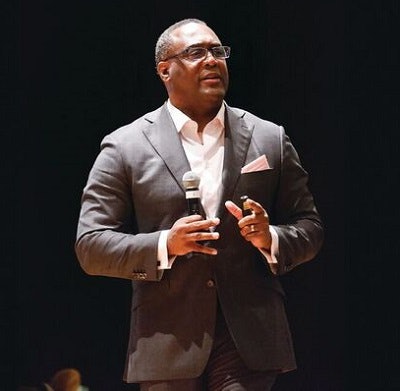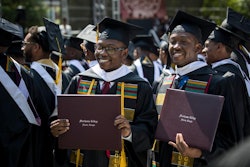When Johnathan M. Holifield talks about future opportunities for HBCUs, he inevitably finds a way to bridge the past to the present, even as he looks toward the future.
For Holifield, the executive director of the White House Initiative on Historically Black Colleges and Universities, these storied institutions are national treasures that can undoubtedly attract continued investment because of their competitive edge and assets.
 Johnathan Holifield
Johnathan Holifield“We preserve national treasures,” says Holifield, sitting inside his office located in the Eisenhower Executive Office Building — home to the headquarters of several high-profile Trump administration officials, including Vice President Mike Pence. “However, we invest in assets, things that we believe will offer a return, that will grow over time. Our institutions are both national treasures and competitive assets.”
As Holifield prepares to mark his second year as head of the Initiative in October, the former NFL player, turned lawyer, entrepreneur and civic leader has won widespread praise for his ability to focus attention on HBCUs and forge significant public and private partnerships that have helped to raise the profile of many of these vulnerable institutions.
“I’ll be honest, I wasn’t convinced that he was the right pick at all when I heard that he was the guy who would lead the Initiative,” says one HBCU president who asked to remain anonymous but has been a staunch critic of President Trump. “But I have been pleasantly surprised and impressed. He’s a creative thinker who seems willing to try and experiment with some new approaches and he does not appear to be a partisan hack.”
Since taking the job, Holifield has barnstormed the nation, visiting 14 of the 19 states that have at least one HBCU. In the process, he has participated in conferences, convenings and brainstormed with college presidents and state officials on how best to hone the competitive advantages and spirit of these historic institutions that mostly emerged in the years following slavery.
“Our institutions are the product of a painful history, America’s original sin,” says Holifield. “We shall never forget that. But they also hold promise for a future America where more Americans are achieving educationally and economically, contributing to where we’re going.”
Even so, Holifield “can put us in the game but he can’t play for us,” quipped one college president about the role of the executive director of the Initiative, which was started in 1981 by President Ronald Reagan.
“At the end of the day, the institutions — not withstanding their excellent advocacy organizations — the institutions themselves are their best advocates,” says Holifield. “In some ways, investing in our institutions is kind of like voting. The franchise is a unique instrument, particularly for those who struggle for the franchise. At once, it pays a debt, honors the debt and those struggles, and at the same time, it makes an investment in the future. That’s what our institutions are. They honor the past, but there is an expectation of future return to our nation as well and that’s a unique kind of characteristic.”
The HBCU impact
Although Holifield never attended an HBCU, he came to learn much about the value of these institutions, primarily from his grandfather, the Reverend Lieutenant Beecher Campbell, Sr.
In his hometown of Romulus, Michigan—the small city sandwiched between Detroit and Ann Arbor — Holifield listened as his grandfather recounted his experience in the early 1900s working on the grounds of what was then Tuskegee Institute, the agricultural college founded by Booker T. Washington.
Although the self-taught preacher never enrolled at Tuskegee, he developed an acquaintance with Washington and when the Great Migration took hold in 1920, he headed north to Michigan in search of a better life and more opportunities.
“Without the presence of then-Tuskegee Institute, what would my grandfather have done? Would my family be here?” asks Holifield. “And that’s part of the less-known story of a kind of diaspora impact that our institutions have had. We less appreciate this multiplier, this exponential impact of having these institutions in our history and what they enabled far beyond the classrooms. It’s a wonderful complimentary narrative of impact.”
There was an expectation that Holifield and his brother and cousins would go on to pursue a college education. In fact, Holifield’s two aunts had gone on to earn advanced degrees and became schoolteachers, while several other relatives became preachers.
As captain of his high school football team, Holifield had his sights on the University of Michigan or Michigan State University, believing that he could compete as an athlete at a Division 1 institution despite his team’s lackluster performance on the field.
“We lost every game. We were 0-9,” he says with a hearty chuckle. “We lost one game, 64 to nothing. We were terrible.”
Despite the losses, his high school basketball coach sent film to West Virginia University of Holifield playing, and the university invited the youngster to come to campus as a walk-on.
In January 1983, Holifield boarded a Greyhound Bus in Detroit to make the six-hour trek to Morgantown, West Virginia.
“I’m going to get you a roundtrip ticket in case this doesn’t work out,” Holifield recalls his mother telling him before he boarded the bus.
 Johnny C. Taylor flanked by President Trump and U.S. Education Secretary Betsy DeVos.
Johnny C. Taylor flanked by President Trump and U.S. Education Secretary Betsy DeVos.“Mama, I’m not coming back until I’m supposed to come back,” he told her. “I’m all in.”
Looking back, Holifield says that by boarding that bus, he was developing his entrepreneurial bona fides, later drawing inspiration from Harvard University professor Howard Stevenson — known as the godfather of entrepreneurship studies — who called entrepreneurship “the pursuit of opportunity without regard to resources currently controlled.”
“It becomes a way of thinking and behaving that can be deployed from everything to the pursuit of an education, to an athletic scholarship, or business creation and formation as well,” says Holifield, who remembers that on that cold January day, he had “about $12 in my pocket and some pork chops that my Mom had made me and they were gone by the time I got to Toledo, only about fifty miles down the road,” as he made the journey to West Virginia University.
Still, he pursued the opportunity beyond the four corners of the resources that he controlled. He walked on the football team at WVU and worked in the cafeteria during his first semester to help pay for room and board. By the fall, he had earned a scholarship, was a starter during his sophomore year and was later elected captain of the team during his senior year.
“It was a great experience,” says Holifield of his time at WVU. “I’m a Mountaineer for life.”
In 1987, Holifield — who majored in political science — was drafted by the Cincinnati Bengals as a running back but was later cut from the team and returned to WVU to finish his fifth and final year of studies.
That same year, the NFL Players Union walked off the job, forcing a strike that lasted for 24 days and caused the season to be shortened to 15 games per team. Needing replacement players, the Bengals summoned for Holifield to rejoin the team.
Having emerged from the Detroit area, where so many of his family members were proud autoworkers and union members, Holifield was torn.
“Crossing that picket line was just not an option for me,” he says. “Now that’s a tough choice. Your dream is to play in the NFL but there’s honor, and what you believe in and how you grew up.”
Holifield opted to remain in school, finished his degree and after he graduated, the Bengals invited him back as a free agent and he played for two years.
“I had intangible qualities that you can’t measure,” he says with a laugh. “Don’t look for my stats. But when I was with the Bengals, we went to the Super Bowl. After they cut me, they went a decade straight without a winning season — a clear cause and effect,” he recalls with humor.
After his football career ended, Holifield completed a master’s degree in education at the University of Cincinnati and contemplated continuing on to earn a doctoral degree but decided instead to go to law school.
“I decided that the diversity of the law degree would probably serve me best,” says Holifield, who was vice president of the Cincinnati Branch of the NAACP during his time as a law student at the University of Cincinnati.
Innovation and competitiveness
Following this civic leadership, Holifield received a call from the president of the Cincinnati Chamber of Commerce who was looking for his assistance in figuring out its role in the new economy.
He took up the challenge, focusing his energy on tech and innovation-based economic development, or what he calls “competitiveness.”
“It transformed my thinking,” says Holifield. “I began to understand the things we were doing in our more traditional organizations was certainly helpful, but boy, there was a big opportunity over here that we just had no real engagement around.”
Holifield became founding executive director of CincyTech (a market-leading venture development organization), and later assumed chief executive roles with the Buffalo Olmsted Parks Conservancy and at the Cleveland Urban League before co-founding ScaleUp Partners, a consultancy committed to connecting underrepresented populations and disaffected communities with innovation ecosystems, its purpose is to grow inclusive and competitive local economies.
In 2017, Holifield penned The Future Economy and Inclusive Competitiveness: How Demographic Trends and Innovation Can Create Economic Prosperity for All Americans, a book that describes the dramatic economic impact that shifting demographic trends will have on America’s economic future, and the pitfalls and opportunities that could accompany the shifts.
“Why focus on competitiveness? Because that’s where the best opportunities are,” says Holifield. “These are not replacement lanes. The imperative is and. All of the things happening that’s good within underserved and distressed communities keep doing it and we have to get in these other lanes that offer our nation’s premier opportunities.”
Is it possible to do both?
“We can, must, have to,” Holifield responds matter-of-factly. “There is no choice. That’s what Americans do. Access what the nation has to offer. We should occupy and contribute to all the lanes that are important to our nation. Contribute value and extract value.”
Leading the Initiative
Shortly after the election of President Donald J. Trump, the administration and officials at the U.S. Department of Education began searching for a new director of the White House Initiative on HBCUs.
Dr. Leonard Haynes, a veteran Department of Education official, was assisting in the search and called Holifield urging him to give some thought to the position.
“When I interviewed and became a serious candidate for it, I’ll be clear as a bell, I wanted it,” says Holifield, who was not deterred even as he learned the particulars about the position. The Initiative employs four career staff and has a meager annual budget of about $130,000.
“It gave me crystal clarity about what the position was not, and at the same time, opened doors for possibilities for what it could be. It was liberating,” he says. “I have a great title. I have a great role. I’m in the executive office of the president, functioning at the senior level of the Department of Education. Let’s get it on.”
For Holifield, the success of the Initiative was largely dependent on entrepreneurship — the willingness to pursue opportunities beyond resources controlled.
“Over the course of my career, I developed some tools and concepts that I thought I could contribute to this effort and that’s what we’ve been working to do,” he says.
U.S. Secretary of Education Betsy DeVos says that she is impressed by Holifield’s ingenuity.
“The White House Initiative on Historically Black Colleges and Universities plays an important role in building partnerships, both public and private, in order to increase the competitiveness of HBCUs and better prepare students for success after graduation,” says DeVos. “Johnathan’s dedication and passion, coupled with his knowledge and expertise, is such an asset, not only to this Administration, but also our nation’s students. We are so pleased to have him on our team.”
As the nation and indeed the world, experience a rapidly changing economic landscape, Holifield says that HBCUs can become even more important on the international stage.
“This sector, I think is at an inflection point and we have huge opportunities. Perhaps not since Reconstruction has the thing our institutions do, and the value they deliver to the nation, been so aligned with the needs of the nation,” he says. “Our institutions were founded, broadly speaking, principally to educate newly freed slaves because the nation needed more educated Americans. Today, possibly more than ever, America needs more talent to maintain a world-leading economy. HBCUs deliver a disproportionately high amount of that talent.”
Despite the diversity of HBCUs, these institutions are bound by their common bond: they were founded principally to educate Black Americans; they were created before 1964 and they remain accredited.
At the federal level, Holifield says that the Domestic Policy Council has convened a policy coordinating committee to develop a federal HBCU competitiveness strategy.
“That has never been done,” says Holifield. “How will the federal government organize its efforts, its agencies to work with HBCUs toward enhanced competitiveness? The executive order is a great enabler of strategy, but it is not a strategy.”
On February 28, 2017, Trump signed an executive order creating the White House Initiative on HBCUs and the President’s Board of Advisors (PBA) on HBCUs, which is led by Johnny C. Taylor, the former head of the Thurgood Marshall College Fund.
The President ordered government agencies that regularly interact with HBCUs to develop annual plans to “strengthen the capacity” of those schools. There are 32 agencies that will submit such plans.
“Now we are seeing increasingly, our federal agencies participating in the federal HBCU Interagency Working Group and developing intra-agency working groups around HBCUs. Pulling together key agency points of contact to work on matters related to HBCUs,” says Holifield. “This creates improved conditions under which our institutions can compete for federal opportunities.”
The Initiative has forged a partnership with The Heritage Foundation to explore HBCU innovation and competitiveness in the non-federal, public and private sectors. Hampton University alum Kay Cole James serves as The Heritage Foundation’s president.
Holifield believes that there is more that can be done.
“In my view, every governor that has at least one HBCU in his or her state should replicate the president’s leadership and issue a gubernatorial HBCU executive order modeled after the president, directing all state agencies to develop HBCU plans,” he says. “How about mayors in cities — some of our cities have a couple of HBCUs — but every city that has at least one, the mayor should issue an executive order directing its city and its departments to develop HBCU plans.”
Holifield sees the creation of Opportunity Zones across the nation as a vehicle that will allow HBCUs additional opportunities “to contribute the things they have — great intellectual capacity, faculty and administrators who have specialized talent,” he says, pointing to the emergence of cybersecurity programs now offered at several HBCUs. “Our institutions can bring to bear all our capacity and potential to help make Opportunity Zones more successful in a variety of ways, not only real estate development, but also research, development and commercialization, entrepreneurship, career pathways and workforce development.”
“We have the freedom to explore all the tools in the toolbox and where there is efficacy, there is nothing stopping the application of those tools to these institutions,” he says.
Taylor says that he’s impressed with Holifield’s vision.
“Few in our community fully appreciate the work that Director Holifield has to do on an almost daily basis to ensure the White House, the Department of Education, and Congress are aligned on what must be done to protect the interests of the HBCU community,” says Taylor, who is now the president and CEO of the Society for Human Resource Management (SHRM), the world’s largest HR professional society. “Were it not for the efforts of Johnathan and the White House Initiative, I can confidently say much of the good work that has been done to benefit HBCUs during the last two years would not be realized.”
Looking forward, Holifield says that he is interested in building sustainability and growth.
“Can we nurture a federal HBCU competitiveness ecosystem? I think we can,” he says. “Why is that important? The system is what persists and endures. Programs come and go. Systems persist.”
This article appeared in the Aug. 8 issues of Diverse. You can follow Jamal Eric Watson on Twitter @jamalericwatson



















